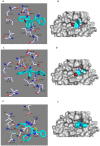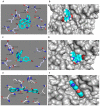Discovery of Two Brominated Oxindole Alkaloids as Staphylococcal DNA Gyrase and Pyruvate Kinase Inhibitors via Inverse Virtual Screening
- PMID: 32093370
- PMCID: PMC7074965
- DOI: 10.3390/microorganisms8020293
Discovery of Two Brominated Oxindole Alkaloids as Staphylococcal DNA Gyrase and Pyruvate Kinase Inhibitors via Inverse Virtual Screening
Abstract
In the present study, a small marine-derived natural products library was assessed for antibacterial potential. Among 36 isolated compounds, a number of bis-indole derivatives exhibited growth-inhibitory activity towards Gram-positive strains (Bacillus subtilis and multidrug-resistant Staphylococcus aureus). 5- and 6-trisindoline (5-Tris and 6-Tris) were the most active derivatives (minimum inhibitory concentration, MIC, 4-8 µM) that were subsequently selected for anti-biofilm activity evaluation. Only 5-Tris was able to inhibit the staphylococcal biofilm formation starting at a 5 µM concentration. In order to investigate their possible molecular targets, both natural products were subjected to in silico inverse virtual screening. Among 20 target proteins, DNA gyrase and pyruvate kinase were the most likely to be involved in the observed antibacterial and anti-biofilm activities of both selected natural products. The in vitro validation and in silico binding mode studies revealed that 5-Tris could act as a dual enzyme inhibitor (IC50 11.4 ± 0.03 and 6.6 ± 0.05 µM, respectively), while 6-Tris was a low micromolar gyrase-B inhibitor (IC50 2.1 ± 0.08 µM), indicating that the bromine position plays a crucial role in the determination of the antibacterial lead compound inhibitory activity.
Keywords: MRSA; antibacterial; antibiofilm; gyrase-B; inverse virtual screening; marine natural products; pyruvate kinase; trisindoline.
Conflict of interest statement
The authors declare there is no conflict of interest.
Figures






References
-
- Manunga J., Olak J., Rivera C., Martin M. Prevalence of methicillin-resistant Staphylococcus aureus in elective surgical patients at a public teaching hospital: An analysis of 1039 patients. Am. Surg. 2012;78:1096–1099. - PubMed
-
- Mittal V. Biofilms in Human Diseases: Treatment and Control. Springer; Cham, Switzerland: 2019. Biofilm and antimicrobial resistance; pp. 285–298.
LinkOut - more resources
Full Text Sources
Miscellaneous

